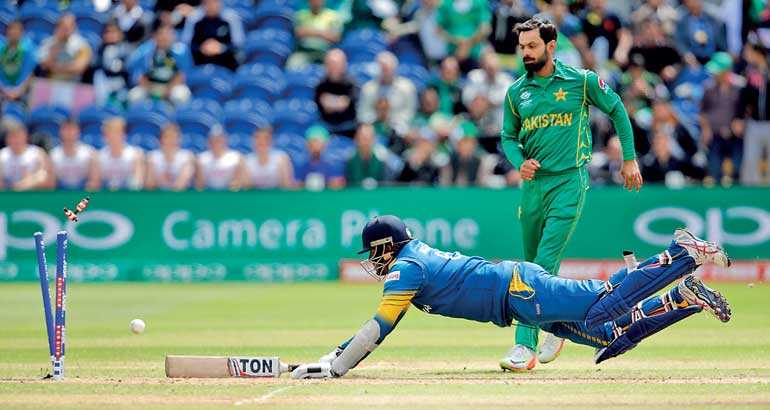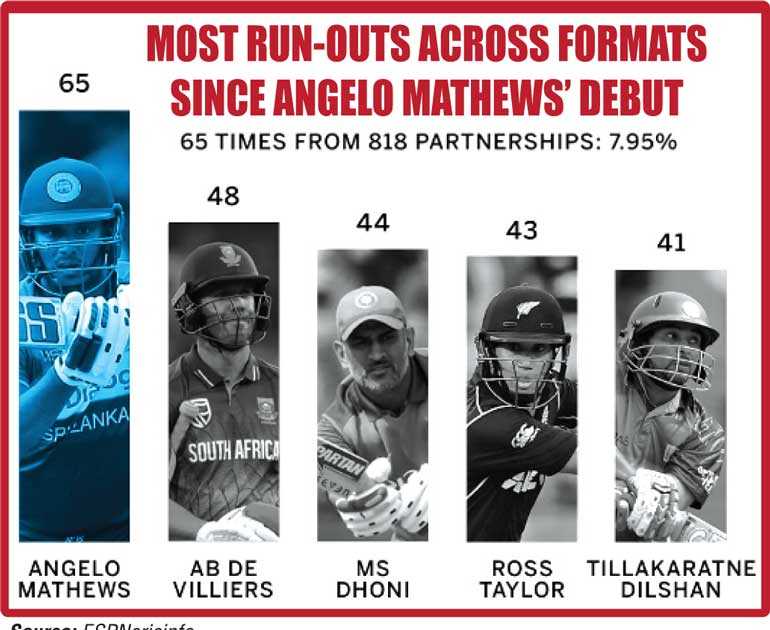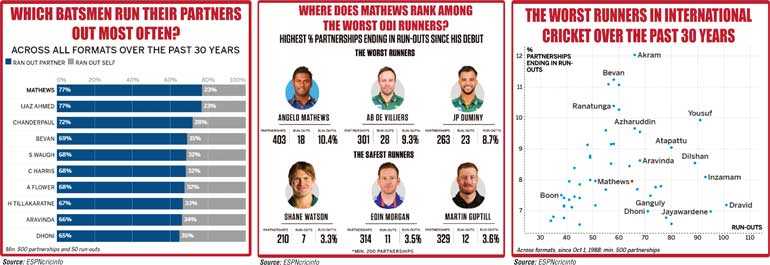Tuesday Nov 04, 2025
Tuesday Nov 04, 2025
Wednesday, 3 October 2018 00:00 - - {{hitsCtrl.values.hits}}


 By Andrew Fidel Fernando and Shiva Jayaraman
By Andrew Fidel Fernando and Shiva Jayaraman
ESPNCricinfo: Angelo Mathews’ recent fall in limited-overs cricket was dramatic. Following Sri Lanka’s embarrassing Asia Cup exit, Mathews was first stripped of the captaincy, then dropped from the one-day team altogether, only 10 months after the same coach and selectors had requested him to lead the team. Chandika Hathurusingha and chief selector Graeme Labrooy have since attempted to publicly explain the decision to axe him, and have landed on three inter-related reasons:
a) Mathews is not “cricket fit”, in that they are not confident he can field for 50 overs, then be relied on to bat effectively for 30 or more overs.
b) Mathews’ running between the wickets in particular is affected by this lack of “cricket fitness”, and he has run out an unusually high number of partners
c) As a result of the two reasons above, Mathews’ presence in the side creates a less-than-ideal “team dynamic”
Hathurusingha spoke most strongly about reasons b) and c), stating that: “Running between the wickets is a very big concern for the whole team at the moment…If you look at his record, he has been involved in about 64 run-outs, and 49 times the opposite guy got run out. That’s a world record.” So do Hathurusingha’s claims stack up? Is Mathews such a poor runner that the selectors’ decision to drop him, despite being the most consistent ODI run-maker in the Sri Lanka side, defensible?
At first glance, Hathurusingha may be on to something. No batsman has been involved in as many run-outs as Mathews since his debut in 2008. In fact, no one even comes close. Mathews has been party to 65 run-outs over his career, across formats - 35% more than the next-worst offender in the time period, which is surprisingly AB de Villiers. Of that total, 42 of the run-outs involving Mathews have come in ODIs.
Also note MS Dhoni’s presence at No. 3 on this list - that will become relevant later in the story.
Mathews has not only racked up a high volume of run-outs since his debut, but it also translates to a high percentage of his partnerships being ended by a run-out. More than a tenth of Mathews’ ODI partnerships have been brought to a close by a run-out. Just to contrast, the overall run-out percentage in ODIs since Mathews’ debut is 6.19%.
A 4.2% run-out percentage change between Mathews’ partnerships and your average ODI partnership does not seem like much, but do keep in mind that run-outs are largely seen as a completely avoidable form of dismissal. Also, remember what Hathurusingha said about Sri Lanka’s “team dynamic”. From a batting partner’s perspective, you are roughly 60% more likely to have your present partnership ended by a run-out if you are batting alongside Mathews, rather than your average ODI batsman.
De Villiers is again the second-worst on this statistical measure, while Shane Watson, Eoin Morgan and Martin Guptill have had the lowest percentage of their ODI partnerships end in run-outs in this period.
We can now be sure that Mathews has registered an unusually high volume and percentage of run-out involvements over a 10-year career, but Hathurusingha’s other point was that the run-outs Mathews was involved in have overwhelmingly led to the dismissal of his partner, rather than himself. This was certainly the case in the recent Asia Cup, where Mathews was party to two running mix-ups in successive games, and was largely to blame for the dismissal of his partner on both occasions.
Overall, his statistics suggest this is a trend for Mathews. In fact, not only is his involvement in dismissals of his partner unusually high for his own playing period, it is the highest - in terms of percentage of overall run-outs - in the last 30 years. In nominal terms, Mathews has been party to a run-out of his partner 50 times, across formats. Which means that of the run-outs he has been involved in, it’s his partner who has lost his wicket 77% of the time.
Although based on the statistics it now seems irrefutable that Mathews is an unusually poor runner, there are some considerations that may temper this view.
First, glance up at the graph above. The top 10 features Michael Bevan, Chris Harris and Dhoni - three batsmen in Mathews’ exact class, by which I mean lower-middle order batsmen and finishers, who are often called upon in the most frantic stage of limited-overs innings (the vast majority of the run-out involvements these players have accrued have come in limited-overs games), and also must frequently bat with the tail (Hashan Tillakaratne was also a lower-middle order man for the majority of his career, even if no one will call him a finisher).
Not only must batsmen like Mathews take many more running risks in trying to retain or regain strike - and in generally trying to score as many as in the death as possible - they are also often justified in letting their partner suffer the dismissal in a run-out situation. For the majority of his career, Mathews’ wicket has been much more valuable to the team in the last quarter of a limited-overs innings - more valuable than any other Sri Lanka batsman you might care to name, tailender or not. He has also run out partners in the course of playing some of his greatest innings, so although some of these statistics appear damning, they do not reflect the particular match situation Mathews was required to deal with. A decision to safeguard his own wicket may have made good cricketing sense in a significant number of these occasions.
Finally, we will address Hathurusingha’s comment about Mathews’ run-out stats being a world record. Strictly speaking, this is untrue, as the graph below lays out.
In terms of pure volume, Mathews does not even crack the Sri Lanka top five in run-out involvement (across formats, last 30 years), with Mahela Jayawardene, Tillakaratne Dilshan, Marvan Atapattu, and Kumar Sangakkara having been involved in more, albeit during longer careers. Rahul Dravid has been involved in more run-outs in this period than any other batsman, but note that does not necessarily make him a poor runner - many other batsmen had a higher percentage of their partnerships end in run-outs. Wasim Akram, for example, had over 12% of his partnerships end in run-outs.
For Mathews, this means that although he is one of the worst runners of his era, he is not a historically terrible runner. And that although the statistics might just support his temporary omission - particularly for the purpose of sending him a message about getting his fitness in order - they don’t conclusively suggest he is so poor between the wickets that his place should be in danger based on his running alone. Plenty of great batsmen have been worse than Mathews, and have enjoyed longer careers.
And a temporary omission is what Hathurusingha and Labrooy are suggesting so far. Hathurusingha has already said he wants Mathews “back as fresh as possible”. He had also famously played a role in removing Shakib Al Hasan in 2014, again because he felt he must send the player a message while making changes to the team culture.
Perhaps Hathurusingha is thinking along the same lines once more.